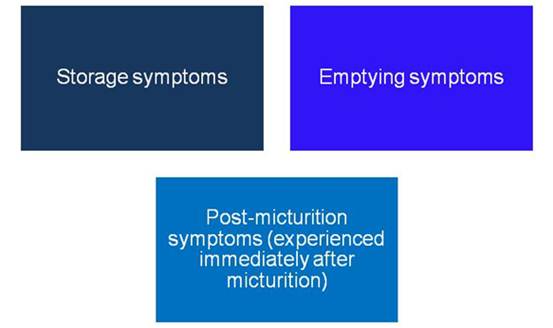Pathophysiology of micturition
Urinary symptoms may relate to problems of storage, bladder emptying, post-micturition symptoms or a combination of these.

Urinary Signs and Symptoms (adapted from Abrams et al, 2002)
Storage symptoms
- Increased daytime frequency (> 8 times per day)
- Nocturia: waking once or more at night to void.
- Urgency: a sudden compelling desire to pass urine which is difficult to defer.
- Urinary incontinence
Emptying symptoms
- Slow, split or intermittent stream
- Hesitancy
- Straining
- High post-void residual
- Terminal dribble: a prolonged final part of micturition, when the flow has slowed.
Post-micturition symptoms (experienced immediately after micturition)
- Feeling of incomplete emptying
- Post Micturition Dribble: the involuntary loss of urine immediately after finishing passing urine.
Task 3
1 |
Task 4
2 |
The International Continence Society (ICS) defines urinary incontinence as "the complaint of any involuntary leakage of urine" (Abrams et al, 2002; p168).
There are a number of identified types of urinary incontinence (Abrams et al, 2002) (Table 2). Select the empty cells on the right of the table to find out more.
Table 1: Types of urinary incontinence
| Type | Signs and Symptoms |
| Stress urinary incontinence |
Leak on exertion e.g. coughing, sneezing. Normal voiding pattern in between |
| Urge urinary incontinence/overactive bladder |
Urgency Involuntary leakage associated with urgency Frequency Nocturia |
| Mixed urinary incontinence | Involuntary leakage on exertion associated with urgency and frequency |
| Acute/Chronic urinary retention (with overflow incontinence) |
Hesitancy Poor Stream Straining to void Patient may or may not have overflow incontinence Frequency Significant post void residual >300ml |
| Reflex incontinence/terminal detrusor overactivity |
Incontinence when the bladder reaches capacity Normal voiding pattern |
| Continuous urinary incontinence | Complaint of continuous leakage |
Task 5
3 |
The different types of urinary incontinence are symptoms of an underlying problem and have a variety of different causes (Table 2).
Table 2: Common types of urinary incontinence and their common causes (Adapted from Wells et al, 2011)
| Type of bladder dysfunction | Causes |
| Stress urinary incontinence | Pregnancy and childbearing, menopause, pelvic floor or urethral sphincter dysfunction |
| Overactive bladder / urge urinary incontinence |
Sensory causes: UTI, indwelling urethral catheters, bladder irritants (e.g. caffeine/alcohol) Motor causes: Multiple Sclerosis (MS), Parkinson's disease, Head injuries, Stroke |
| Chronic urinary retention - with or without detrusor sphincter dyssynergia |
Outflow obstruction: Constipation and faecal impaction, blocked urinary catheter, urethral strictures, prostatic enlargement Neurogenic causes: MS, Spinal Cord Injury, Guillain-Barré syndrome, other peripheral neuropathies e.g. diabetic neuropathy |
| Reflex incontinence/ Terminal detrusor overactivity | Dementias, acute confusional disorders, unconscious and sedated patients |
| Continuous urinary incontinence | Usually due to a vesico-vaginal or vesico-rectal fistula. |